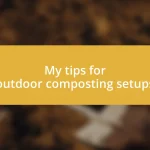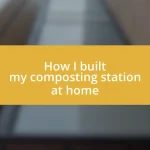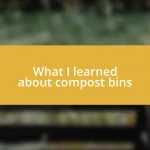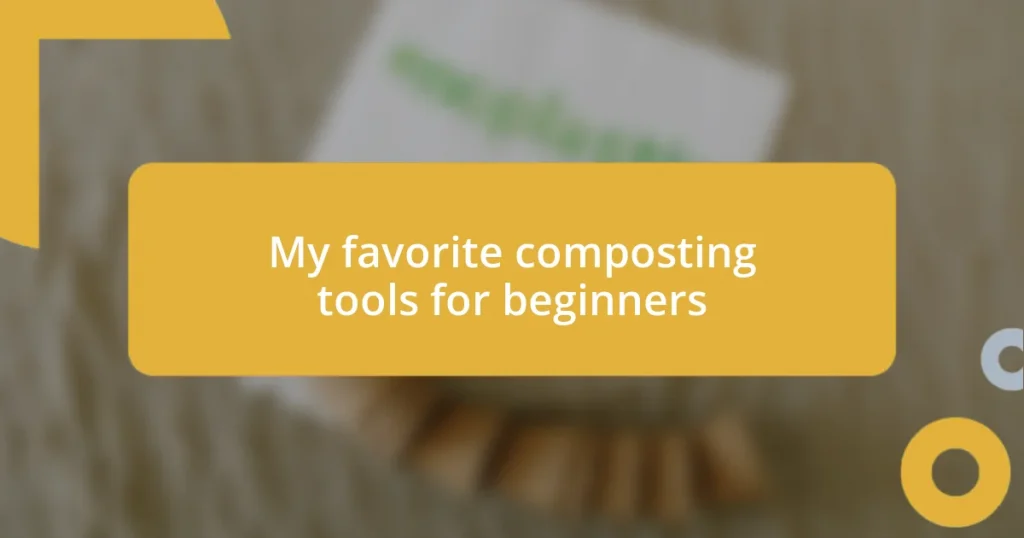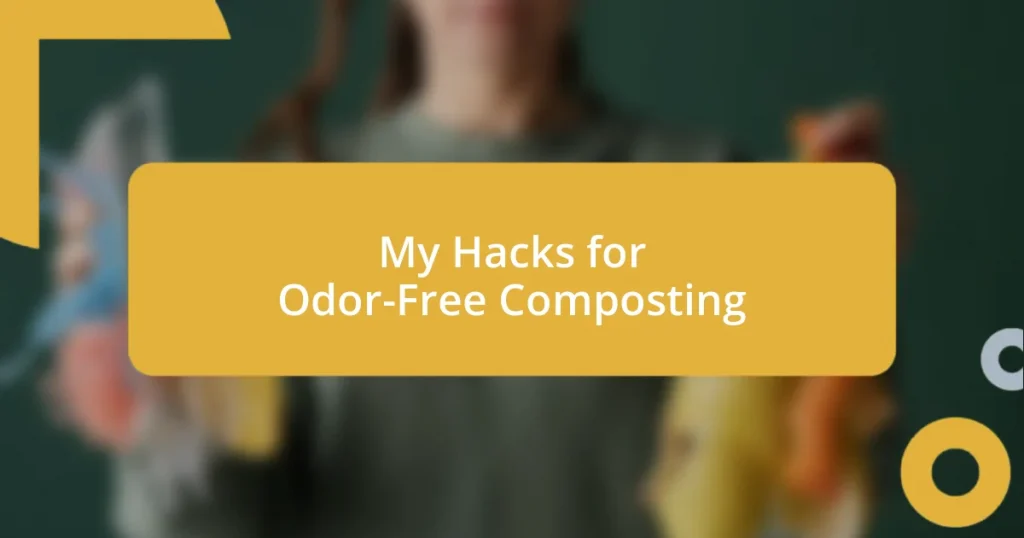Key takeaways:
- Composting involves balancing greens (nitrogen-rich) and browns (carbon-rich) while ensuring proper aeration and moisture for healthy decomposition.
- Regularly turning your compost pile enhances microbial activity and prevents odors by introducing air and redistributing materials.
- Harvesting finished compost not only benefits garden health but can also enrich potting mixes, showcasing the transformative power of composting.
- Awareness of common issues like odor, slow decomposition, and dryness allows for effective troubleshooting and maintenance of the composting process.

Understanding compost basics
Composting is a natural process that transforms organic waste into nutrient-rich soil. When I first started composting, I was amazed at how simple kitchen scraps could turn into something so beneficial. Have you ever felt the satisfaction of repurposing food waste instead of throwing it away? That’s the magic of composting.
At its core, composting requires three essential ingredients: greens, browns, and air. Greens are nitrogen-rich materials like fruit peels and vegetable scraps, while browns include carbon-rich items like dried leaves and cardboard. I remember one time, I added too many greens without enough browns, and my pile started to smell. It really taught me the importance of balance!
It’s also crucial to keep your compost pile aerated and moist. When I dig into my pile and see those worms thriving, I can’t help but feel a deep connection to the ecosystem. Do you ever stop and wonder about the life teeming in your compost? Keeping it wet but not soggy is key; it’s just like nurturing a garden, where every component plays a role in creating something beautiful.

Choosing the right compost materials
When it comes to selecting compost materials, I’ve learned that variety is essential. Mixing different types of greens and browns not only adds diverse nutrients but also helps in achieving the right balance. I vividly recall the first summer I composted; I was so excited about my kitchen scraps that I didn’t think to complement them with enough browns. It was a real eye-opener when my pile became too wet, creating a mushy mess. I quickly found out that incorporating materials like dried leaves and straw made all the difference in maintaining that ideal texture and moisture level.
Choosing the right materials also means being mindful of what not to include. I’ll never forget the time I accidentally tossed some citrus peels into my compost. The next day, I realized that too much acidity can harm the microbial life vital for decomposition. That incident taught me that I needed to steer clear of dairy, oils, and meats, as these can attract pests and cause unpleasant odors. Creating a compost pile is a learning journey!
Finally, consider the size of your compost materials. I prefer chopping larger items into smaller bits; it speeds up decomposition significantly. For example, breaking down banana peels not only helps them break down faster but also allows me to witness a more active decomposition process. Each time I turn my pile, I feel a little thrill at seeing the transformation happening, reinforcing my connection to sustainability and nurturing the earth.
| Compost Material Type | Characteristics |
|---|---|
| Greens | Nitrogen-rich; includes fruit scraps, vegetable peels, coffee grounds |
| Browns | Carbon-rich; includes dried leaves, paper, and cardboard |
| Avoid | Meat, dairy, and oils; can attract pests and cause odor |
| Size Consideration | Chop larger items to speed up decomposition |

Building your compost pile
Building a compost pile is a bit like crafting a living ecosystem. I remember the thrill of my first attempt; I gathered everything from kitchen scraps to garden waste and tossed it all together in a pile. The excitement was palpable! But soon, I realized it could be a little more methodical. The key is to alternate layers of greens and browns, allowing for a diverse mix that encourages healthy decomposition.
Here’s a quick guide to structuring your compost pile effectively:
- Layering: Start with a base of coarse browns like small branches or straw to aid drainage.
- Greens First: Add a layer of greens, like vegetable scraps, to kickstart the nitrogen action.
- Browns Next: Follow with browns—things like dried leaves, which help absorb excess moisture.
- Repeat: Alternate these layers until your pile reaches a manageable height of about three feet.
- Turn Regularly: Tossing and turning your pile every few weeks introduces air, invigorating the microbial activity.
I actually got my hands dirty during a recent weekend when I turned my pile and found a hidden treasure: the rich, dark soil at the bottom! It felt like unearthing gold. That moment truly emphasized how a well-built compost pile can lead to vibrant soil ready for my garden beds, completing the cycle of life.

Maintaining moisture and temperature
Maintaining the right moisture level in your compost pile is crucial for decomposition. I’ve learned that the ideal moisture should feel similar to a damp sponge—not dripping wet but moist enough to hold together. There have been times when I neglected this part, only to find my compost pile had dried out, slowing down the decomposition process. A simple sprinkle of water usually does the trick, but I make sure to check it regularly, especially during warm weather.
Temperature is another vital aspect that I’ve come to appreciate in my composting journey. Interestingly, I’ve found that a well-managed compost pile can reach temperatures of 130°F to 160°F (54°C to 71°C), which is perfect for breaking down materials effectively. Whenever I’ve noticed my pile feeling a little too cool, I’ve responded by turning it more frequently to aerate it and encourage that essential heat generation. It’s fascinating to feel the warmth radiating from the pile after a good turn; it’s like a gentle reminder of the life buzzing within.
Incorporating moisture and temperature management into my routine has made my composting experience much more rewarding. I often think about how easy it is to get caught up in the excitement of adding new scraps, but if I neglect to maintain these elements, it can lead to disappointment. Reflecting on those moments, I realize that checking moisture and monitoring temperature are simple yet effective practices that keep my compost thriving and full of life.

Turning and aerating your compost
Turning and aerating your compost is a vital part of nurturing that living ecosystem. Whenever I take the time to turn my pile, I can visually see and feel the transformation happening. It’s almost magical—mixing those layers of greens and browns, redistributing moisture, and providing airflow helps the bacteria thrive. Have you ever dug into your pile and felt that warmth? It’s a sign that the microbes are hard at work!
In my experience, I find that every two to four weeks is the sweet spot for turning. I remember one Saturday when I let it go a bit longer than I should have. The pile was compact and dense, and pulling it apart took a lot more effort than usual. I realized it was a missed opportunity to recharge the microbial action that drives decomposition. Now, I look forward to turning it; it feels like giving my compost a booster shot of life.
A simple tool, like a pitchfork, can make the job easier and more enjoyable. I like to approach it as a small workout, getting both fresh air and exercise. Plus, I’ve adopted a habit of checking for any aromas while turning. If it smells sweet and earthy, I know I’m on the right track. It’s experiences like these that make me appreciate the intricate dance of decomposition—it’s not just compost; it’s life in transformation!

Troubleshooting common compost issues
If your compost has an unpleasant odor, it might be a sign that it’s too compacted or lacking oxygen. I remember a particular instance when I caught a whiff of something off while tending to my pile. It turned out to be a result of not turning it often enough, which led to anaerobic conditions. I quickly got to work with my pitchfork, breaking things up and mixing in some leaves for better aeration. The smell dissipated almost immediately, and seeing my compost regain its earthy scent felt rewarding.
Another common issue I’ve encountered is a pile that just doesn’t seem to be breaking down. After some introspection, I realized this was often a result of adding too many large pieces or not enough greens, like grass clippings or vegetable scraps. I recall feeling frustrated one time when I pulled back the layers only to find large chunks of kitchen waste still intact. Now, I make it a point to chop up larger items into smaller pieces before adding them. It’s amazing how a little preparation can significantly speed up the decomposition process!
Sometimes, you may notice that your compost seems too dry. I’ve faced this challenge, especially during those hot summer months. On one sweltering afternoon, I could almost see the dust rising from my pile; it was definitely time for action. I learned to keep a watering can nearby, making it easy to add moisture whenever I need to. A little sprinkle goes a long way, and it’s a simple reminder that even a thriving compost pile needs a drink now and then!

Harvesting and using finished compost
Once your compost is ready, harvesting it can feel like a little celebration. I remember the first time I sifted through my pile, my fingers running through the rich, crumbly texture. It sparked such joy to see the transformation from kitchen scraps to nutrient-dense compost. I usually use a simple garden fork to remove the finished compost from the bottom, which feels almost meditative as I uncover this treasure.
When it comes to using my finished compost, I like to think of it as a gift to the garden. Just last spring, I mixed a good handful into the soil of my vegetable beds, and it was incredible to see the plants respond. Have you ever noticed how a sprinkle of compost can make flowers blossom and veggies thrive? It’s like giving them a burst of energy! Each season, I carefully distribute it around my plants, ensuring they get the nutrients needed to flourish.
One thing I’ve learned is that finished compost isn’t just for the garden; it can also make an excellent additive for potting mixes. I recall enriching my houseplants’ potting soil with it last year, and the vibrant results were astonishing. The rich, dark color and earthy scent brought a bit of life back into my indoor space. It’s rewarding to see how a cycle of decomposition can feed not just the earth but also the life around us.



